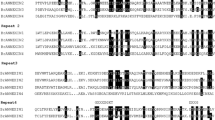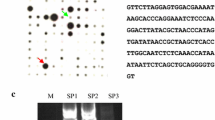Abstract
An early light-inducible protein (GbELIP) isolated from immature ginkgo leaves by rapid amplification of cDNA ends method contains a 570 bp open reading frame encoding a 189 amino acid protein, with significant homology to early light-inducible proteins from other plant species. The genomic DNA of GbELIP gene contains three exons and two introns. Southern blotting revealed that GbELIP is a single-copy gene in ginkgo. Light, defense and stress responsive element were found in the promoter region of GbELIP. GbELIP expressional patterns were detected by Real-time PCR at various conditions. ELIP expressions were variable at different time points of 1 day and increasing significantly at the commencement of light illumination then dropping to a basal level gradually. ELIP expression in small size leaves (1–1.5 cm width and 7-day age) was higher then middle (2–3 cm width and 15-day age) and large (4 cm width and 30-day age) size leaves. It revealed that ELIP expression was under the control of developmental regulation. Under temperature and light intensity treatments, GbELIP transcripts accumulation may relate to photoinhibition. The peak expression of GbELIP appeared later by chilling than heating. Meanwhile, GbELIP expression under high light was higher than low light at both two temperatures. GbELIP expression was also increased by wounding and methyl jasmonate (Me-JA) treatment, but not corresponded with increasing malondialdehyde (MDA) concentration. In conclusion, GbELIP appears to be induced by an imbalance between chlorophyll formation and degradation during development or under abiotic stress. These results suggest that GbELIP may function in response to environmental signals, possibly regulating responses to abiotic stresses.








Similar content being viewed by others
References
Adamska I, Kloppstech K, Ohad I (1992) UV light stress induces the synthesis of the early light-inducible protein and prevents its degradation. J Biol Chem 267:24732–24737
Araújo SS, Duque AS, Silva JM, Santos D, Silva AB, Fevereiro P (2013) Water deficit and recovery response of Medicago truncatula plants expressing the ELIP-like DSP22. Biol Plantarum 57:159–163
Bartels D, Hanke C, Schneider K, Michel D, Salamini F (1992) A desiccation related Elip-like gene from the resurrection plant Craterostigma plantagineum is regulated by light and ABA. EMBO J 11:2771–2778
Binyamin L, Falah M, Portnoy V, Soudry E, Gepstein S (2001) The early light-induced protein is also produced during leaf senescence of Nicotiana tabacum. Planta 212:591–597
Bruno AK, Wetzel CM (2004) The early light-inducible protein (ELIP) gene is expressed during the chloroplast-to-chromoplast transition in ripening tomato fruit. J Exp Bot 55:2541–2548
Cai R, Xu F, Chen LJ, Cheng SY (2007) Modification of total RNA isolation method from different Ginkgo biloba organs. Biotechnology 17:38–41
Casazza A, Rossini S, Rosso M, Soave C (2005) Mutational and expression analysis of ELIP1 and ELIP2 in Arabidopsis thaliana. Plant Mol Biol 58:41–51
Fowler S, Thomashow MF (2002) Arabidopsis transcriptome profiling indicates that multiple regulatory pathways are activated during cold acclimation in addition to the CBF cold response pathway. Plant Cell 14:1675–1690
Grimm B, Kloppstech K (1987) The early light-inducible proteins of Barley. Eur J Biochem 167:493–499
Grimm B, Kruse E, Kloppstech K (1989) Transiently expressed early light-inducible thylakoid proteins share transmembrane domains with light-harvesting chlorophyll binding proteins. Plant Mol Biol 13:583–593
Han J, Kim G (2013) An ELIP-like gene in the freshwater green alga, Spirogyra varians (Zygnematales), is regulated by cold stress and CO2 influx. J Appl Phycol 25:1297–1307
Heddad M, Adamska I (2000) Light stress-regulated two-helix proteins in Arabidopsis thaliana related to the chlorophyll a/b-binding gene family. P Natl Acad Sci USA 97:3741–3746
Heddad M, Noren H, Reiser V, Dunaeva M, Andersson B, Adamska I (2006) Differential expression and localization of early light-induced proteins in Arabidopsis. Plant Physiol 142:75–87
Hodges DM, DeLong JM, Forney CF, Prange RK (1999) Improving the thiobarbituric acid-reactive-substances assay for estimating lipid peroxidation in plant tissues containing anthocyanin and other interfering compounds. Planta 207:604–611
Hutin C, Nussaume L, Moise N, Moya I, Kloppstech K, Havaux M (2003) Early light induced proteins protect Arabidopsis from photooxidative stress. P Natl Acad Sci USA 100:4921–4926
Kolanus W, Scharnhorst C, Kühne U, Herzfeld F (1987) The structure and light-dependent transient expression of a nuclear-encoded chloroplast protein gene from pea (Pisum sativum L.). Mol Gen Genet 209:234–239
Lescot M, Déhais P, Thijs G, Marchal K, Moreau Y, Van de Peer Y, Rouzé P, Rombauts S (2002) PlantCARE, a database of plant cis-acting regulatory elements and a portal to tools for in silico analysis of promoter sequences. Nucleic Acids Res 30:325–327
Lindahl M, Funk C, Webster J, Bingsmark S, Adamska I, Andersson B (1997) Expression of ELIPs and PS II-S protein in spinach during acclimative reduction of the Photosystem II antenna in response to increased light intensities. Photosynth Res 54:227–236
Livak KJ, Schmittgen TD (2001) Analysis of relative gene expression data using Real-time quantitative PCR and the 2−ΔΔCt Method. Methods 25:402–408
Maxwell K, Johnson GN (2000) Chlorophyll fluorescence—a practical guide. J Exp Bot 51:659–668
Meyer G, Kloppstech K (1984) A rapidly light-induced chloroplast protein with a high turnover coded for by pea nuclear DNA. Eur J Biochem 138:201–207
Montané M-H, Dreyer S, Triantaphylides C, Kloppstech K (1997) Early light-inducible proteins during long-term acclimation of barley to photooxidative stress caused by light and cold: high level of accumulation by posttranscriptional regulation. Planta 202:293–302
Montané M-H, Petzold B, Kloppstech K (1999) Formation of early-light-inducible-protein complexes and status of xanthophyll levels under high light and cold stress in barley (Hordeum vulgare L.). Planta 208:519–527
Noren H, Svensson P, Stegmark R, Funk C, Adamska I, Andersson B (2003) Expression of the early light-induced protein but not the PsbS protein is influenced by low temperature and depends on the developmental stage of the plant in field-grown pea cultivars. Plant, Cell Environ 26:245–253
Osipenkova OV, Odintsova MS, Yurina NP (2010) The influence of light, hormonal, and carbohydrate signal systems on ELIP gene expression in gun-mutants Arabidopsis thaliana. Appl Biochem Micro 46:331–338
Peng Y, Lin W, Wei H, Krebs SL, Arora R (2008) Phylogenetic analysis and seasonal cold acclimation-associated expression of early light-induced protein genes of Rhododendron catawbiense. Physiol Plantarum 132:44–52
Pinto F, Berti M, Olivares D, Sierralta WD, Hinrichsen P, Pinto M (2011) Leaf development, temperature and light stress control of the expression of early light-inducible proteins (ELIPs) in Vitis vinifera L. Environ Exp Bot 72:278–283
Radić S, Radić-Stojković M, Pevalek-Kozlina B (2006) Influence of NaCl and mannitol on peroxidase activity and lipid peroxidation in Centaurea ragusina L. roots and shoots. J Plant Physiol 163:1284–1292
Sävenstrand H, Olofsson M, Samuelsson M, Strid Å (2004) Induction of early light-inducible protein gene expression in Pisum sativum after exposure to low levels of UV-B irradiation and other environmental stresses. Plant Cell Rep 22:532–536
Shimosaka E, Sasanuma T, Handa H (1999) A Wheat Cold-Regulated cDNA Encoding an Early Light-Inducible Protein (ELIP): its Structure, Expression and Chromosomal Location. Plant Cell Physiol 40:319–325
Tao L, Zeba N, Ashrafuzzaman M, Hong CB (2011) Heavy metal stress-inducible early light-inducible gene CaELIP from hot pepper (Capsicum annuum) shows broad expression patterns under various abiotic stresses and circadian rhythmicity. Environ Exp Bot 72:297–303
Tzvetkova-Chevolleau T, Franck F, Alawady AE, Dall’Osto L, Carrière F, Bassi R, Grimm B, Nussaume L, Havaux M (2007) The light stress-induced protein ELIP2 is a regulator of chlorophyll synthesis in Arabidopsis thaliana. Plant J 50:795–809
Wang XA, Peng YH, Singer JW, Fessehaie A, Krebs SL, Arora R (2009) Seasonal changes in photosynthesis, antioxidant systems and ELIP expression in a thermonastic and non-thermonastic Rhododendron species: a comparison of photoprotective strategies in overwintering plants. Plant Sci 177:607–617
Wei H, Dhanaraj A, Rowland L, Fu Y, Krebs S, Arora R (2005) Comparative analysis of expressed sequence tags from cold-acclimated and non-acclimated leaves of Rhododendron catawbiense Michx. Planta 221:406–416
Wierstra I, Kloppstech K (2000) Differential effects of methyl jasmonate on the expression of the early light-inducible proteins and other light-regulated genes in barley. Plant Physiol 124:833–844
Yu LH, Zhang CS and Liang H (2006) Extract of DNA from ginkgo leaves and its RAPD amplification. Biotech Bull:81–84
Zarter CR, Adams WW, Ebbert V, Cuthbertson DJ, Adamska I, Demmig-Adams B (2006) Winter down-regulation of intrinsic photosynthetic capacity coupled with up-regulation of Elip-like proteins and persistent energy dissipation in a subalpine forest. New Phytol 172:272–282
Zeng Q, Chen X, Wood AJ (2002) Two early light-inducible protein (ELIP) cDNAs from the resurrection plant Tortula ruralis are differentially expressed in response to desiccation, rehydration, salinity, and high light. J Exp Bot 53:1197–1205
Acknowledgments
This research was supported by the foundation of excellent doctoral dissertation in Nanjing Forestry University, the plan of scientific research innovation of graduate students in general college (CXZZ12_0546), national nature science foundation (31170627) and nature science foundation of Jiangsu province (BK2010019). We thank Tongli Wang, a research associate in the University of British Columbia’s Department of Forest and Conservation Science, for giving us so many suggestions on structure arrangement of this paper. Thanks for Robin Mellway, a post-doctor fellow with the University of British Columbia’s Department of Forest and Conservation Sciences, on editing of wording and grammar in the paper.
Author information
Authors and Affiliations
Corresponding author
Additional information
Communicated by S. Abe.
Electronic supplementary material
Below is the link to the electronic supplementary material.
Rights and permissions
About this article
Cite this article
Wang, H., Cao, F., Li, G. et al. The transcript profiles of a putative early light-induced protein (ELIP) encoding gene in Ginkgo biloba L. under various stress conditions. Acta Physiol Plant 37, 1720 (2015). https://doi.org/10.1007/s11738-014-1720-8
Received:
Revised:
Accepted:
Published:
DOI: https://doi.org/10.1007/s11738-014-1720-8




